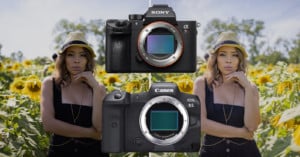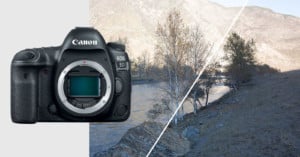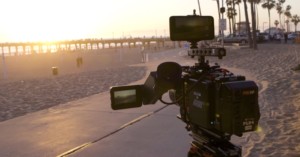
The Occasionally Severe Dynamic Range Cost of Electronic Shutters
William "Bill" Claff of Photons to Photos recently added numerous cameras to his fantastic and vast library of photographic dynamic range tests, including the Panasonic Lumix G9 II.

William "Bill" Claff of Photons to Photos recently added numerous cameras to his fantastic and vast library of photographic dynamic range tests, including the Panasonic Lumix G9 II.

Last week, RED unveiled a pair of new large-format global shutter cinema cameras, the V-Raptor (X) and V-Raptor (X) XL. Tedious model names aside, these cameras have 40.96 x 21.6-millimeter image sensors and make lofty promises concerning dynamic range.

While PetaPixel is currently deep in its real-world test of the upcoming Sony a9 III (expect that review in the next couple of weeks), Richard Butler from DPReview just published a studio test that highlights a very real issue with the global shutter: noise.

The Sony a9 III is still months away from release but has already sent photographers into a frenzy. The positive buzz around the camera is as high as any camera reveal ever, and with good reason. The a9 III's global shutter system is a complete game-changer for a wide range of photographers and videographers and will enable shots that have long been impossible.

Last year, Sony said that it had developed a new type of sensor that was capable of gathering double the light of conventional sensors while also reducing noise. That sensor has finally made it into a consumer product, and the company has further explained how it works.

Panasonic has touted additional benefits of the organic CMOS sensor that it has been working on for nearly a decade, and while the developments still sound enticing, the company seems no closer to release.

No doubt most of us have found ourselves in the following situation... You’ve discovered a beautiful landscape scene that you’ve carefully composed in your camera’s viewfinder. Your camera is on a tripod and there’s no wind, so you’re feeling confident that you’ll be able to capture everything in one shot with both a small aperture and a slow shutter speed. Things are looking great!

We’ve all heard the term "dynamic range" when reading the latest and greatest offerings of camera manufacturers -- "this camera has the highest dynamic range in its category!" We understand that a greater dynamic range is generally a good thing to have.

Sony is set to provide Apple with a "state-of-the-art" image sensor for its next iPhone that will supposedly double the amount of light it can capture and give it the ability to clearly capture a face even with a strong backlight.

In December of 2021, Sony successfully developed the world’s first stacked CMOS image sensor technology with two-layer transistor pixels, doubling its light gathering capability. The company has now further detailed how this was achieved.

Sony's Semiconductor division has announced that it successfully developed the world's first stacked CMOS image sensor technology with two-layer transistor pixels that grants double the light gathering capability.

According to data on Photons to Photos, while the Panasonic GH5 Mark II uses the same sensor as the previous GH5, the company has somehow managed to squeeze even more dynamic range out of it and notably surpassing the original GH5.

On March 25, Sigma announced the 61-megapixel fp L camera that features a new autofocus system and much more resolution than the original fp. The company has provided a few images captured on the camera, and the quality looks impressive.

Portrait photographer and YouTuber Manny Ortiz recently set out to compare the new Canon EOS R5 against his go-to workhorse, the Sony a7R III. But in addition to doing a general side-by-side usability comparison, he was looking at one thing in particular: dynamic range.

Canon Japan recently announced a new "high-sensitivity CMOS Sensor" that can capture high-quality, color footage a 1080p and up to 60fps even in extremely low light. The sensor is meant for industrial use, but it shows what's possible, even when you're using relatively tiny pixels.

A few months back, the guys at The Slanted Lens posted a video comparing the performance of various sensor sizes and it... didn't go well. The comments were filled with complaints (valid and otherwise) about how they'd handled the test, and so they decided to address some of those concerns and run a whole new test.

Given all of the overheating controversy and the intense focus on the camera's 8K and 4K video capabilities, you'd be forgiven for forgetting that the Canon EOS R5 is also a stills camera. But Gordon Laing at Cameralabs didn't forget, and he's reviewed this camera specifically for stills photographers.

Earlier today, DXOMark issued an apology. The popular sensor testing company revised its controversially low score for the Canon 1D X Mark III, admitting that "erroneous testing data" had affected the scoring and screwed up their initial review. In other words: this sensor is much better than they thought.

JP Morgan and Kenneth Merrill over at The Slanted Lens have put together an in-depth sensor size comparison that will definitely spark some conversation. They've compared medium format, full-frame, APS-C and Micro Four Thirds, in a side-by-side shootout—taking identical photos and making large prints to see how the image quality and dynamic range compares across formats.

"Compression" is a dirty word in the world of photography, but not all compressed files are created equal. That's exactly what photographer Alex Barrera discovered when he switched to using Canon's compressed RAW (cRAW) format exclusively—it's saved him a ton of space, with virtually no downsides.

Using a graduated neutral density (GND) filter is fairly easy and doesn’t require any advanced techniques in post-production, but the easiest option isn’t always the best choice; due to the filter’s transition being horizontal, anything above the distinction will be darkened and anything below will be left alone.

Photonstophotos has published its dynamic range test results for the new Canon EOS R and Nikon Z7 full-frame mirrorless cameras. The numbers show that both Canon and Nikon trail the performance of Sony's cameras.

The new Nikon Z7 mirrorless camera and the Nikon D850 DSLR both have 45.7MP backside-illuminated full-frame sensors, so one might reasonably assume that the two cameras have virtually identical image quality. But it turns out the Z7 actually falls short in the area of dynamic range due to banding.

The Chinese smartphone manufacturer Vivo is trying to beat Google at the HDR game. It has unveiled a new AI-powered feature called "Super HDR," which claims to produce better high dynamic range photos with more natural results.

Canon released its 6D Mark II in 2017, and the Internet has been abuzz ever since then discussing its high ISO performance. There have been reports that the Mark II creates more noise at high ISOs than the original 6D.

DPRSplit is a new utility by LibRaw (the makers of FastRawViewer and RawDigger) that lets you squeeze extra dynamic range out of Canon 5D Mark IV RAW files. It may sound like magic, but the program works by separating the data captured by the DSLR's Dual Pixel sensor.

The new Nikon D850 is a beast of a camera by pretty much all accounts, but how does it stack up against other rival cameras and the D810 it replaces? In this image quality comparison by Tony Northrup, see whether the new camera is really a full-stop improvement over the D810 as Nikon claims.

The first dynamic range tests of the new Canon 6D Mark II DSLR are trickling onto the Web, and one thing seems to be clear: the results are very disappointing for Canon fans. In fact, Canon appears to have taken a step backwards.

Photons to Photos has updated its Photographic Dynamic Range versus ISO Setting test database with results from the new Sony a9, and it found that the a9 holds its own against the flagship Nikon D5 and Canon 1D X Mark II DSLRs.

As the saying goes, "There's no such thing as a free lunch." And it looks like this applies to camera tech as much as anything else. According to a new report, the Sony a9 had to sacrifice some dynamic range to reach the crazy 20fps speeds everyone is so excited about.

A few months back, a viral video showed how the iPhone 7 could (in some respects) hold its own against a $50,000 RED Weapon. This side-by-side comparison of the iPhone 7 Plus against an $82,000 Arri Alexa is a bit more... what you expect.

Want to learn how to blend 3 bracketed exposures of the same scene to create a single photo with greater dynamic range? Here's a great 17-minute video tutorial by travel photographer and educator Jimmy McIntyre on how to do so in Photoshop CC.

With the advent of better camera technology and clever processing software, do we really need neutral density filters any more? Can’t we just replicate the effect of filters in Photoshop or even in camera? Isn’t the dynamic range sufficient in my shiny new Sony camera? Well, yes and no…

Here's the before/after shot I promised yesterday which showcases the not-too-shabby dynamic range and noise control of the Canon EOS 5D Mark IV. But I don't want to talk about it any longer. Instead, I'd like to say this.

I love toys... camera equipment toys, that is. And thanks to my never-ending photographic ADD, I have owned a lot of different cameras. I have a pretty good understanding of most of the different camera makes and models that are on the market today. I’ve shot most of them to some degree, and I have been able to really dial in what works best for me as a professional wedding photographer.

Since I got my Nikon D7000 camera 6 years ago I’ve used it almost everyday. That is a lot of shutter clicks, 148,558 to be exact. It looks like I will be in the market for a new camera soon as the D7000 is only factory tested to 150,000 clicks. My dilemma is should I go full frame, or stick with my cropped frame?

There have been precious few Fujifilm X-T2's out in the wild ahead of this morning's release, but travel photographer Elia Locardi has had one for the last 2 months and he's sharing a crazy dynamic range demo with us today.

Pentax fans have been waiting for the full-frame K1 with bated breath, and the first impressions coming out of the review community seem to indicate they haven't been holding their breath for nothing. In fact, a new test report claims the K1's dynamic range can compete with medium format!

Back in 2010, we reported that a California-based startup called InVisage was working on a new image sensor technology called QuantumFilm, which uses "quantum dots" to make sensors that are several times more sensitive to light than traditional sensors.
Now, 5 years later, the first short film shot with the technology has been released. You can see what the sensor can do in the 7.5-minute short above, titled "Prix."

In a world in which photographs are primarily taken with digital image sensors, there are a growing number of photographers who are newly interested in film formats of the past. But why would anyone in our age of technological convenience still choose to shoot with analog film?